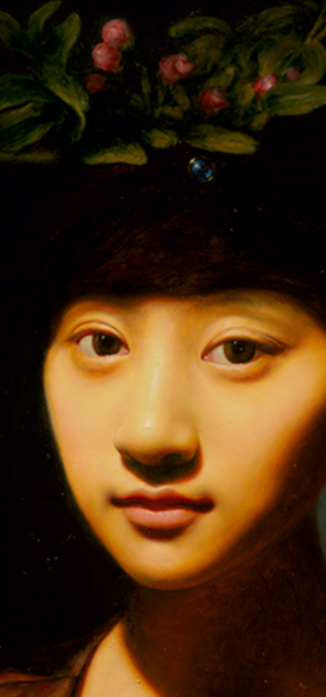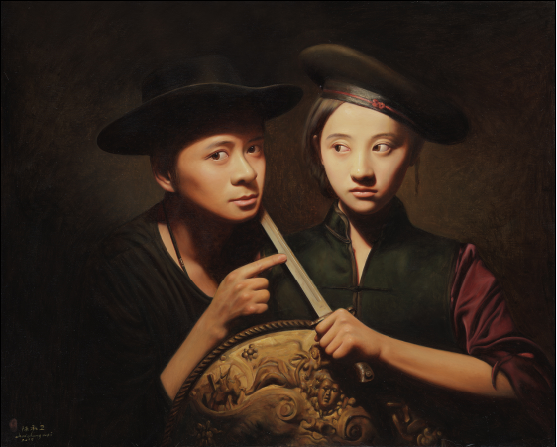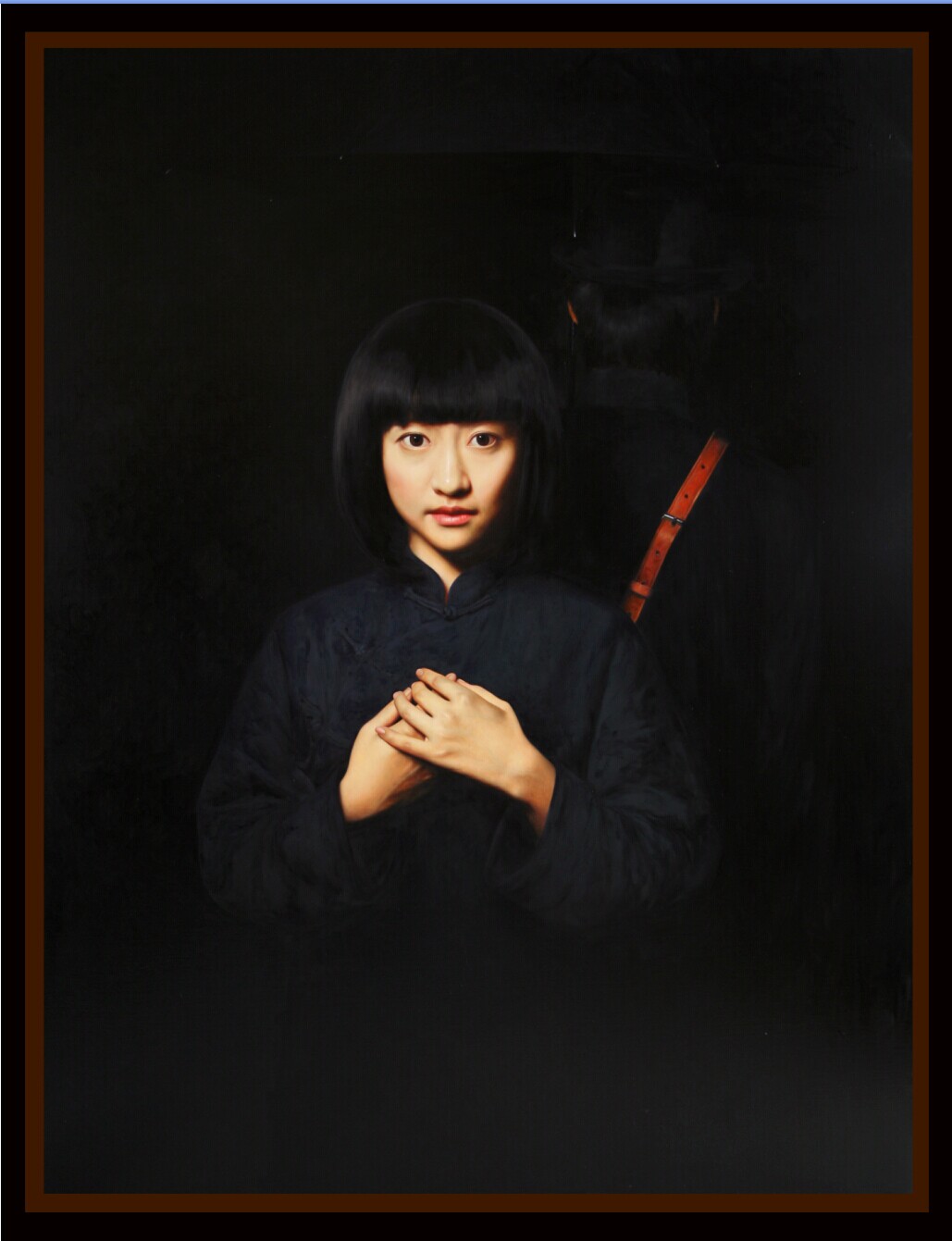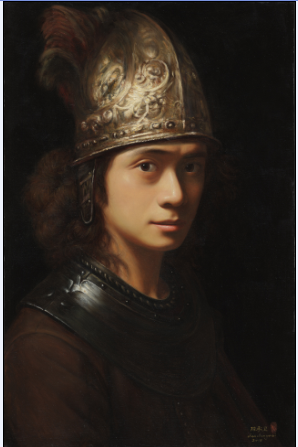从“自我”到“无我”的思想创作修炼
友人: 黄予、杨勇/文
陈承卫作为一位与佛有缘的青年具象绘画“修行者”,一方面进行着“自我修行”,另一方面在不断思索自己艺术创作的命题。通过《大民国》这一时代主题,不断结合自己的修行和环境去加以诠释,在生活中去探索,在探索中去感悟契合,并跟随这一主题创造出属于自己的艺术语言。

《大民国》是陈承卫对民国时代的一份特殊文化情结,他的作品具有托马斯˙哈代的悲观主义色彩与徐志摩式的忧郁情绪气质。因为在那个短暂而又激荡的历史时期是一个宏大的思潮时代,是一段曲折的艰辛岁月,也是一曲忧伤的人文情怀,在中西方、新旧体制间的不同文化思想影响下,《大民国》具有一种内在的淡淡幽情和外在的精神风骨。
他的“民国范儿”表现出大时代环境下的一种“自我”解读,通过对历史的穿越,折射出新旧思想的碰撞,从而在内容上产生“戏剧化”冲突,表达了艺术家对现实生活的某种主观批判。在这些创作中包含了他的个人情感、生活以及环境事物的多种因素,作为艺术创作过程的主体,他注重观察和体验现实生活,关注人的思想状态和内心世界,通过对精神和艺术创作的活动,以及自我加工和再创造,使作品具有了强烈的自我意识和丰富情感。
同时,他把抽象的思想修炼与概念的创作过程有机结合,在意识中将自己的构思、人物与空间相组合形成审美意象,运用人物不同形态来塑造不同的审美情愫,展现一种经过理想化“改造”的民国时代。《大民国》是一段复杂而又漫长的创作过程,期间经历了艺术家不同的阶段和实践,在对事物环境本质与普遍性有了更新认识之后,其具有了更为深刻的思想内涵。

佛学的修行方法是思维修炼,是通过思维思考来进行修行。为此,他远离大城市的喧嚣和浮躁,奔赴世界各地学习和领略西方大师优秀作品,让自己尽可能在独立思考中静下心来。伴随着对艺术理解的不断加深,他努力使自己进入一种“禅定”的思想境界,去思索艺术创作,在这种艺术思维修炼中,领悟“无我”的思想共相性。“诸行无常,一切皆苦,诸法无我,寂灭为乐”代表了修行者的修炼方向,对于年轻的艺术“修行者”来说,他需要在漫长的生活中不断探索艺术创作的思想真谛,去思考其中的“自我”主题。

Psychology Creation and Cultivation from "Ego" to "No Ego"
Friends: Huang Yu, Yang Yong
As a youth figurative painting "practitioner" sharing an affinity with Buddha, Chen Chengwei takes up the "self-training", and meanwhile continuously ponders his own propositions of artistic creation. By the theme of times of The Great Republic of China, Chen Chengwei continuously combines his self-training with environment to make an interpretation, makes an exploration in life, feels inspiration and finds correspondence in exploration, and creates his own artistic language by following this theme.
The Great Republic of China reflects Chen Chengwei’s special culture complex towards the Republic of China, and has the pessimism of Thomas Hardy and the gloomy temperament of Xu Zhimo. Because the short and turbulent historical period is a great era of ideological trend, a period of meandering hard years, as well as a humanistic feeling weighed down with sorrows, The Great Republic of China has a kind of inherently light exquisite feelings and external spirit character under the influence of different cultural thoughts among the Chinese and western, old and new systems.

His "style of Republic of China" shows a kind of interpretation of "ego" in the environment of great times, reflects the collision between new and old ideas by historical crossing, and consequently produces "dramatic" conflicts in contents, expressing the artist's some subjective criticism on real life. The creation consists of a variety of factors such as his personal feelings, life, and environment. As the subject of artistic creation, he focuses on observing and experiencing real life, pays attention to the mind state and inner world of people, and endues the works with a strong sense of self-awareness and rich emotion through the activities of spiritual and artistic creation, as well as the self-processing and re-creation.
At the same time, he integrates the abstract thought cultivation with conceptual creation process organically, combines his own conception with characters and space in consciousness together to form aesthetic images, and utilizes the different character postures to mold different esthetic feelings, so as to reveal the period of Republic of China through idealized "transformation". The Great Republic of China undergoes a complex and long creation process, witnesses the artist's different stages and practices, and has a more profound thought connotation following the artist's update understanding of essence and universality of environment.

The cultivation method of the Buddhism is a kind of thinking cultivation, and the training of the Buddhism is realized by thinking. For this reason, he keeps himself away from the noisy and vanity of metropolis, and goes around the world to study and appreciate the outstanding works of the western masters, so as to keep himself calm down in independent thinking as much as possible. Along with the deepening understanding of art, he tries to put himself in a kind of ideological level of "absorption in meditation" so as to ponder the artistic creation and comprehend the thought commonness of "no ego" in the cultivation of artistic thinking. "Every phenomenon is impermanent; nothing is unrelated to suffering; no self can be found in anything; nirvana is the ultimate happiness." shows the cultivation direction of practitioner. As for a young art "practitioner", he needs to continuously explore the true essence of thought in artistic creation and think the "ego" theme therein.







